May 2013
Seal yoga class at Alki today
May/28/13 10:40 PM
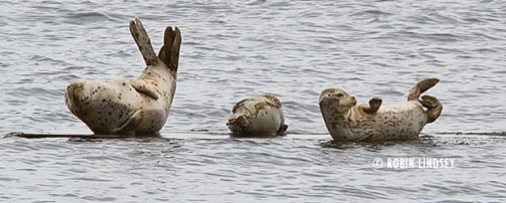
Soon, a new wave of seal pups will be born in South Puget Sound as pupping season gets underway in mid-late June. We could start seeing some of these new pups on West Seattle’s shores as early as July. There was an unconfirmed report of a premature pup at Ballard’s Golden Gardens recently. The high season for seal pups in West Seattle is Fall. As always, if you come across a pup onshore, stay back and call Seal Sitters’ hotline at 206-905-7325 (SEAL).
ALERT: Seal pupping season underway on the outer coast
May/26/13 01:50 PM
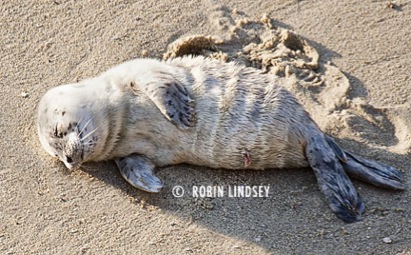
It is normal for a seal pup to be alone on the beach. Occasionally a mother harbor seal will leave her pup to rest while she forages for food, returning to nurse him. If there are people and dogs too close, she may abandon the pup. Most times, however, the pup will accompany mom to learn how to forage. Once pups are weaned at 4-6 weeks, they will be all on their own, using shoreline daily to rest and warm up before returning to the water. Seals of all ages rest on shore about 50% of their day. Undisturbed, stress-free rest is crucial to their survival.
Seal pupping season begins in South Puget Sound in late-June, extending into September. As pups are weaned in our area rookeries, they venture off to surrounding areas. West Seattle’s busiest months for newly weaned seal pups are September and October. For a map showing pupping seasons in the various regions of Washington state, click here.
Click the links for a map of stranding networks in the Pacific Northwest: Washington map | Oregon map
Seal Ambassador drive launches at Alki Summer Streets
May/24/13 07:20 AM
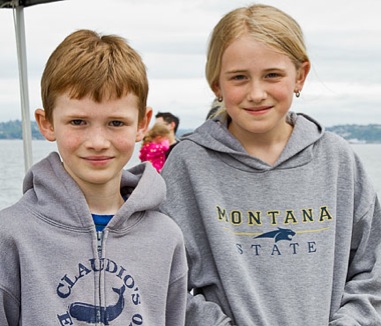
Seal Sitters’ volunteers staffed a booth at the event and launched our “Seal Ambassador” drive, asking local kids to take a pledge to protect our marine environment. Harrison and Annabelle (shown here), students at Schmitz Park Elementary School, are our very first Ambassadors. Thanks to both of them and the additional 33 kids who took the pledge on Sunday! If you’d like to be one of Spud’s Seal Ambassadors, email us here.
178 people stopped by the booth throughout the day, learning about seals and other marine mammals, NOAA’s Marine Mammal Stranding Network, and Seal Sitters’ Year of the Seal (YOS) educational outreach project and harbor seal mom and pup sculpture. Our very talented illustrator Lynn created life-size chalk sketches on the street of a gray whale and swimming seal mom and pup, which were a big hit with the public. A table was set up next to our booth, where children colored drawings Lynn created - drawings showing what does and doesn’t belong on the beach and in the water, part of our YOS project to show the devastating impact that trash and pollution have on marine life. Flipper hugs to our enthusiastic and dedicated volunteers for spending their day doing outreach and helping marine wildlife!
GiveBIG a success for seals and other marine mammals
May/18/13 10:05 AM
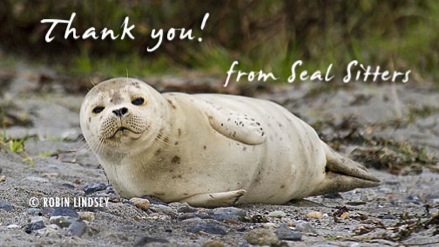
These new donations will help greatly in our goal to finance the installation of the Georgia Gerber bronze sculpture of a mother seal and her pup - and to fund the educational components of the Year of the Seal project, including the unveiling ceremony and celebration event at Alki Beach on September 8th. We still have quite a ways to go to meet our financial needs for the project, but this is a fantastic start!
We will continue to seek additional funds throughout the year to meet our funding needs. Donations can always be made through the blog and website.
Thanks so much for making this sculpture dream become a reality! Find out more about our Year of the Seal educational outreach project.
Surprise gift on Mother's Day - seal pup at Lincoln Park
May/14/13 08:29 PM
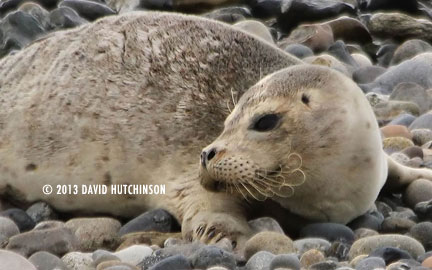
That began a long day for volunteers, watching over the pup, nicknamed Carnation, until dark. Walkers, runners and bicyclists had lots of questions - including one woman who was concerned the pup had a head wound. Our responder Lynn assured her that indeed it was the pup’s ear hole and not a wound, a common misconception by people who erroneously report dead harbor seals as shot in the head. In the photo here you can see that harbor seals (unlike sea lions) don’t have external ear flaps.
You can also see that Carnation has some unusually curly whiskers, known as vibrasse. These whiskers, filled with highly sensitive nerves, help seals locate food in the dark and in deep waters by picking up vibrations from moving prey. One recent scientific study reveals that seals may not only be able to detect fish up to 600 feet away using solely their whiskers, but also the size and shape of prey. Researcher Wolf Hanke says, “This strongly suggests that the seal can sense different species of fish. If the seal can avoid tracking fish that are too small or too big, this saves energy” (NY Times). Each highly sensitive whisker (seals have 40-50 on each side of their snout) has up to 1500 nerves at the base. The research shows that a harbor seal’s whiskers are as efficient at detecting fish as echolocating dolphins.
Thanks to all the volunteers who gave up their Mother’s Day to be an allomother (when a human or other animal provides maternal care for the young born by another) to Carnation!
Give BIG to Seal Sitters on May 15th
May/06/13 05:20 PM
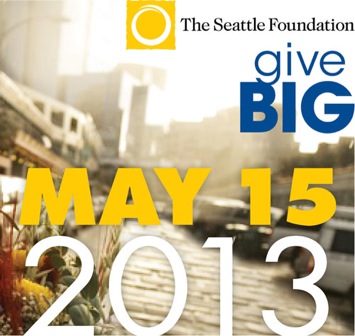
Please support Seal Sitters through The Seattle Foundation's GiveBIG, a one-day, online charitable giving event inspiring people to give to nonprofit organizations in our region. Your donation will be partially matched by The Seattle Foundation. This is an easy way to make your donation dollars multiply.
YOU COULD WIN A GOLDEN TICKET!
If your donation is chosen by The Seattle Foundation in a random drawing of 10 lucky winners, you and Seal Sitters will further benefit. Seal Sitters will then receive an additional $1,000 donation and a round trip ticket courtesy of Alaska Airlines. And, as a Golden Ticket winner, you will receive a $100 gift card, courtesy of Starbucks!
IT'S EASY TO DONATE!
Click this link to participate in GiveBIG. PLEASE NOTE! The GiveBIG link is only active on May 15th!
On May 15th, this link will take you to the page for Associated Recreational Council which is our fiscal sponsor. Click on DONATE and then fill in your financial and personal information. In the "Comments" box you must type in Seal Sitters. Then we will be credited with your donation. This is extremely important! If you do not type in Seal Sitters, your donation will go to ARC's general funds and Seal Sitters will not receive your donation.
TELL YOUR FRIENDS!
Please also spread the word to your family, friends, and business contacts by sending this post to them, encouraging a donation to Seal Sitters on May 15th. Anyone can donate through this GiveBig program.
Seal Sitters MMSN receives no funding from NOAA, the State or City for the work we do. Funds are needed for our dedicated hotline, website hosting, stranding materials, educational outreach and gas reimbursement. Some funds may be used for our Year of the Seal project.
If you have any questions, please email JoDean Edelheit.
Juvenile harbor porpoise strands on private beach
May/01/13 07:03 PM
Seal Sitters responded this afternoon to a call about a dead harbor porpoise on private property near the Alki Lighthouse. The juvenile male, estimated to be between 2-3 years old, was an intact, fresh specimen and was taken for necropsy by Jessie Huggins of Cascadia Research. The animal was somewhat thin and had some lacerations on the tail. Thanks to Jessie for giving our responders an on-the-beach lesson today on harbor porpoise biology. This is only the third stranded harbor porpoise we have had in West Seattle since 2007.The necropsy will be performed by Cascadia’s John Calambokidis with his marine biology students at Evergreen State College. We will share the findings as we receive them.
Over the past few years, the harbor porpoise has been rebounding in South Puget Sound after experiencing a mysterious decline decades ago. As stocks increase, so do the number of deaths - many due to commercial fishing gear entanglements (especially gill nets) and emerging infectious diseases. The harbor porpoise that died off Alki last March had a severe lung infection caused by a highly contagious fungus. Biologists such as Calambokidis are working to increase research and get more accurate population estimates of these shy and elusive animals.
One of the smallest marine mammals, harbor porpoises reach lengths of 5-6 feet (with females larger than the males) and weigh an average of about 125 lbs. As the name suggests, they prefer shallow waters and frequent harbors, bays and estuaries. They have sleek, dark gray bodies with lighter undersides, blunt heads and live approximately 20 years.
If you see harbor porpoises (or other cetaceans) in South Puget Sound, please report the sighting to Cascadia Research @ 360-943-7325. If you find any dead marine mammal, call your local stranding network (click here for listings in Washington and Oregon). Marine mammals can carry zoonotic diseases (transmittable from animals to humans). Do not touch a dead animal and always keep dogs away. Thanks to waterfront residents Susan and her daughter Jessica who called the hotline and allowed us access to the beach through their property!
Over the past few years, the harbor porpoise has been rebounding in South Puget Sound after experiencing a mysterious decline decades ago. As stocks increase, so do the number of deaths - many due to commercial fishing gear entanglements (especially gill nets) and emerging infectious diseases. The harbor porpoise that died off Alki last March had a severe lung infection caused by a highly contagious fungus. Biologists such as Calambokidis are working to increase research and get more accurate population estimates of these shy and elusive animals.
One of the smallest marine mammals, harbor porpoises reach lengths of 5-6 feet (with females larger than the males) and weigh an average of about 125 lbs. As the name suggests, they prefer shallow waters and frequent harbors, bays and estuaries. They have sleek, dark gray bodies with lighter undersides, blunt heads and live approximately 20 years.
If you see harbor porpoises (or other cetaceans) in South Puget Sound, please report the sighting to Cascadia Research @ 360-943-7325. If you find any dead marine mammal, call your local stranding network (click here for listings in Washington and Oregon). Marine mammals can carry zoonotic diseases (transmittable from animals to humans). Do not touch a dead animal and always keep dogs away. Thanks to waterfront residents Susan and her daughter Jessica who called the hotline and allowed us access to the beach through their property!







